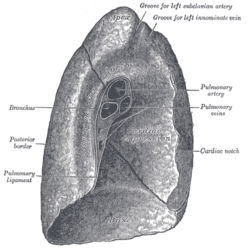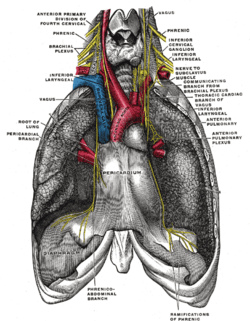Root of the lung
| Root of the lung | |
|---|---|
 Mediastinal surface of right lung. | |
 Mediastinal surface of left lung. | |
| Details | |
| Identifiers | |
| Latin | radix pulmonis |
| Dorlands /Elsevier | r_02/12688029 |
| TA | A06.5.01.016 |
| FMA | 268155 |
The Root of the Lung is located at the hilum of each lung, just above the middle of the mediastinal surface and behind the cardiac impression of the lung. It is nearer to the back (posterior border) than the front (anterior border). The root of the lung is connected by the structures that form it to the heart and the trachea. The rib cage is separated from the lung by a two-layered membranous coating, the pleura. The hilum is the large triangular depression where the connection between the parietal pleura (covering the rib cage) and the visceral pleura (covering the lung) is made, and this marks the meeting point between the mediastinum and the pleural cavities.
The root is formed by the bronchus, the pulmonary artery, the pulmonary veins, the bronchial arteries and veins, the pulmonary plexuses of nerves, lymphatic vessels, bronchial lymph glands, and areolar tissue, all of which are enclosed by a reflection of the pleura.
The root of the right lung lies behind the superior vena cava and part of the right atrium, and below the azygos vein. That of the left lung passes beneath the aortic arch and in front of the descending aorta; the phrenic nerve, pericardiacophrenic artery and vein, and the anterior pulmonary plexus, lie in front of each, and the vagus nerve and posterior pulmonary plexus lie behind.
The chief structures composing the root of each lung are arranged in a similar manner from the front to the back on each side. This means that the upper of the two pulmonary veins are in front, the pulmonary artery is in the middle, and the bronchus and bronchial vessels are behind.
Structures
The arrangement on the two sides is not symmetrical.
Right side: (superior to inferior) Eparterial bronchus, pulmonary artery, hyparterial bronchus and pulmonary vein
Left Side: (superior to inferior) Pulmonary artery, bronchus and pulmonary vein.
Also on each hilum there are hilar bronchopulmonary lymph nodes.
The parietal pleura surrounding the root of the lung extends downwards from the hilum in a fold called the pulmonary ligament. The lower end of this is sometimes referred to as the inferior pulmonary ligament. At the lower edge of each lung the pleural layers come into contact with each other and terminate in a free curved edge. The pulmonary ligaments serve to hold the lower part of the lungs in position.
Additional images
-

The phrenic nerve and its relations with the vagus nerve.
References
This article incorporates text in the public domain from the 20th edition of Gray's Anatomy (1918)
External links
- Atlas image: lung_lymph at the University of Michigan Health System - "Transverse section through lung"
- thoraxlesson2 at The Anatomy Lesson by Wesley Norman (Georgetown University)
- Diagram at seer.cancer.gov (#21)
| ||||||||||||||||||||||||||